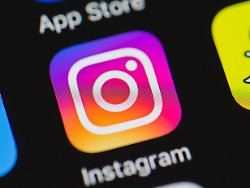When Instagram was launched ten years ago, users mainly used the online picture service to edit their photos. However, it was not just the fashion industry that quickly discovered that digital marketing strategies can reach millions of potential customers.
A lunch, a handbag, a dream beach perfectly staged in pretty photos: the online picture service Instagram came onto the market a decade ago – and has since changed the way we eat, travel and consume. When Kevin Systrom and Mike Krieger started a social network to share photos on October 6, 2010 in the USA, the app developed for smartphones offered new filters for adjusting brightness, contrast and colors. With it you could create the perfect photo in no time – and that was extremely well received.
Whether vacation, party or a visit to a restaurant – everything became a backdrop for self-portraits to post and comment on. When Instagram was bought by Facebook two years after its launch, it was already the world's most popular platform for selfies. Internet stars and other celebrities reach tens of millions of people around the world via Instagram. Kylie Jenner of the Kardashian clan has 196 million followers.
"We have entered the age of 'internet reality', in which we can only exist through what we post on social media", analyzes Michaël Stora, psychologist and chairman of the research collective Observatory for Digital Worlds in France. "I take selfies, therefore I am," the scientist sums up.
Instagram produced countless influencers
The app has become the favorite platform for luxury brands, especially fast fashion labels, which can target millions of users there with digital marketing strategies. A shopping function introduced in 2019 transformed Instagram into an e-commerce site with which companies can use their profiles as virtual shop windows: your target group can shop and pay here without leaving the app.
Instagram brought forth countless influencers who provide their loyal followers with photos, videos and purchase recommendations on a daily basis. "The brands send me the product and I offer the entire service around it," says 36-year-old Pauline Privez, who has been a fashion and beauty influencer since 2009. "You no longer have to contact an advertising agency, we take care of everything."
In addition, fashion manufacturers now woo consumers exactly where they are, without intermediaries: their pictures are displayed on the mobile phones of their target group between two posts and in the same square format.
For the luxury industry in particular, Instagram is proving to be a blessing, as the labels can now interact with users on a daily basis via their own accounts, explains fashion historian Audrey Millet: "By publishing free content, they open up to everyone and thus create the snobbish image that stuck to them so far. "
Chasing Instagram Likes
The app has also brought about changes in the catering industry: since users have been posting photos of their avocado toast or immortalizing their latte macchiato on Instagram, restaurant operators have been relying on carefully staged photos of food and interior to attract customers. Some offer table reservations directly through Instagram.
Since Instagram is also used for vacation planning, many tourist offices rely on Instagram to advertise their destinations. Influencer Privez goes on sponsored trips six to seven times a year, in return posts her "experiences" and receives additional money for it.
But for many young people, the hunt for Instagram likes has become an addiction and that could have devastating effects, warns Internet expert Stora. In particular, Instagram gives adolescents a false picture of reality and creates a striving for perfection "which they cannot do justice to". Influencers are also feeling this pressure. Privez drew conclusions from this: "At work, I am forced to stay on Instagram, but in my private life I break away from it more and more."
.
